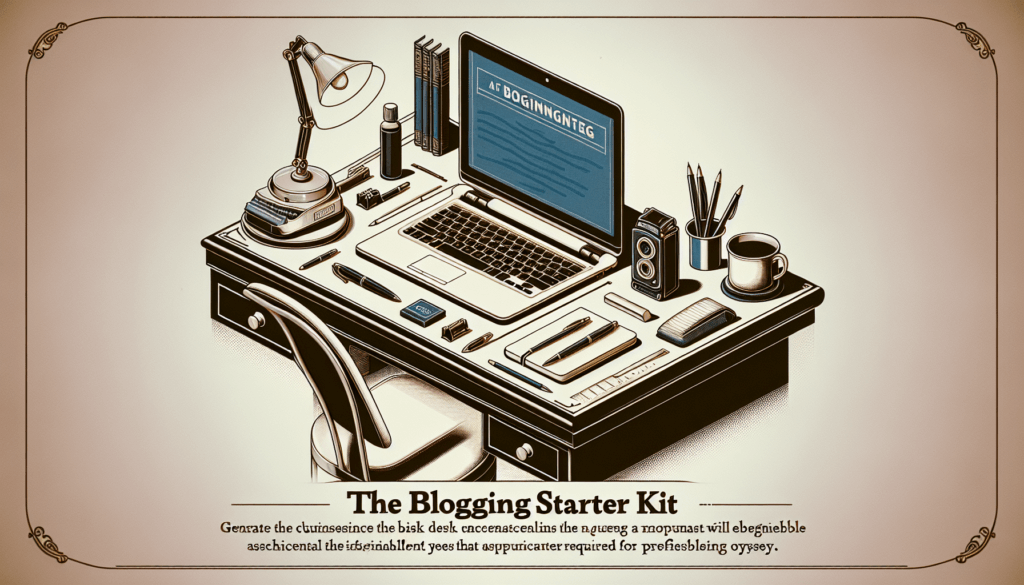If you’re just starting out on your blogging journey, you may be feeling a mixture of excitement and overwhelm. The good news is that there are plenty of blogging tools out there designed specifically for beginners like you, making the process a whole lot easier and more enjoyable. In this article, we’ll introduce you to the top 10 blogging tools that are essential for any beginner blogger. From content management systems to keyword research tools and social media schedulers, we’ve got you covered with everything you need to kickstart your blogging career. So, let’s jump right in and explore the world of blogging tools together!

Keyword Research Tools
Keyword research is an essential part of blogging. It helps you identify the right keywords to target in your content, improving your chances of ranking higher in search engine results and driving more organic traffic to your blog. Here are three powerful keyword research tools that every beginner blogger should consider:
1. Google Keyword Planner
One of the most widely used keyword research tools is Google Keyword Planner. It is a free tool that allows you to find relevant keywords, explore search volume data, and get ideas for new keywords. Google Keyword Planner provides valuable insights into the popularity and competitiveness of keywords, helping you make informed decisions about your content strategy.
2. SEMrush
SEMrush is a comprehensive SEO tool that offers a wide range of features, including keyword research. With SEMrush, you can analyze your competitors’ keywords, identify new keyword opportunities, and track your rankings for specific keywords. The tool also provides valuable data on search volume, keyword difficulty, and related keywords, allowing you to optimize your content for maximum visibility.
3. Ahrefs
Ahrefs is another popular SEO tool that offers advanced keyword research capabilities. With Ahrefs, you can discover the most important keywords in your niche, analyze your competitors’ keyword rankings, and find content gaps that you can fill with your own blog posts. The tool also provides detailed insights into search volume, keyword difficulty, and organic traffic potential, helping you make data-driven decisions about your content strategy.
Content Creation Tools
Creating high-quality content is crucial for the success of your blog. These content creation tools will help you write engaging and error-free blog posts:
1. WordPress
WordPress is a popular content management system (CMS) that makes it easy to create and manage your blog. It offers a user-friendly interface, a wide range of customizable themes, and powerful plugins that extend the functionality of your blog. With WordPress, you can create and publish blog posts, add images and multimedia content, and optimize your content for search engines.
2. Grammarly
Grammarly is a must-have tool for any blogger who wants to produce error-free content. It is a writing assistant that automatically detects grammar, spelling, punctuation, and style mistakes in your writing. Grammarly provides suggestions for corrections and helps improve your overall writing skills. Whether you’re writing a blog post, an email, or a social media update, Grammarly ensures that your content is polished and professional.
3. Hemingway Editor
The Hemingway Editor is a simple yet effective tool that helps you write clear and concise blog posts. It highlights long and complex sentences, unnecessary adverbs, and passive voice, allowing you to simplify your writing and improve readability. The Hemingway Editor also provides a readability score, indicating the grade level required to understand your content. By using this tool, you can make your blog posts more accessible and engaging for your readers.
Graphics and Design Tools
Visual content plays a crucial role in attracting and engaging readers. These graphics and design tools will help you create stunning visuals for your blog:
1. Canva
Canva is a user-friendly graphic design tool that allows you to create professional-looking visuals even if you have no graphic design experience. It offers a wide range of templates, fonts, and images that you can customize to match your blog’s branding. With Canva, you can create eye-catching blog post graphics, social media images, infographics, and more.
2. Adobe Photoshop
Adobe Photoshop is a powerful photo editing and design software used by professionals. While it has a steeper learning curve compared to Canva, it offers advanced features and limitless creative possibilities. With Photoshop, you can edit and enhance your photos, create custom graphics, and design visually stunning blog post templates.
3. Piktochart
Piktochart is a versatile infographic maker that allows you to create informative and visually appealing infographics for your blog. It provides a wide range of templates, icons, and charts that you can customize to convey complex information in a visually engaging way. With Piktochart, you can create infographics that not only attract attention but also help you establish yourself as an authority in your niche.
SEO Tools
Optimizing your blog for search engines is crucial for driving organic traffic. These SEO tools will help you improve your search engine rankings and visibility:
1. Yoast SEO
Yoast SEO is a popular WordPress plugin that helps you optimize your blog posts for search engines. It provides real-time analysis of your content, suggesting improvements for SEO best practices such as keyword usage, meta tags, readability, and more. Yoast SEO also generates XML sitemaps, handles canonical URLs, and integrates with social media platforms, making it a comprehensive tool for on-page SEO optimization.
2. Moz
Moz is a suite of SEO tools that offers both free and paid features. It provides valuable insights into your website’s performance, competitive analysis, and link building opportunities. With Moz, you can track your keyword rankings, identify technical SEO issues, and optimize your site for local search. The tool also offers a community where you can ask questions and gain insights from SEO experts.
3. Google Analytics
Google Analytics is a powerful web analytics tool that provides in-depth data about your website’s performance. It tracks visitor behavior, traffic sources, conversion rates, and more, helping you understand how users interact with your blog. With Google Analytics, you can identify which content performs well, track your marketing campaigns, and make data-driven decisions to improve your blog’s performance.

Social Media Management Tools
Managing your social media presence is crucial for promoting your blog and engaging with your audience. These social media management tools will help you streamline your social media marketing efforts:
1. Hootsuite
Hootsuite is a popular social media management tool that allows you to schedule and publish posts across multiple social media platforms from one dashboard. With Hootsuite, you can monitor mentions, engage with your audience, and track your social media performance. The tool also provides analytics and reports to help you measure the effectiveness of your social media marketing campaigns.
2. Buffer
Buffer is another social media scheduling tool that helps you plan and publish content seamlessly across different social media platforms. With Buffer, you can schedule posts in advance, collaborate with your team, and analyze your social media performance. The tool also provides a browser extension, making it easy to curate and schedule content while browsing the web.
3. Sprout Social
Sprout Social is a comprehensive social media management tool that goes beyond scheduling and publishing posts. It offers features such as social listening, social media analytics, and customer engagement. With Sprout Social, you can monitor conversations about your brand, measure the impact of your social media campaigns, and provide timely responses to your audience. The tool also offers collaboration features, making it easy to coordinate social media efforts with your team.
Email Marketing Tools
Email marketing is an effective way to nurture your audience and drive traffic to your blog. These email marketing tools will help you create and manage engaging email campaigns:
1. Mailchimp
Mailchimp is a popular email marketing platform that offers a wide range of features for beginners. It allows you to create and send professional-looking email campaigns, manage your subscriber lists, and track the performance of your emails. Mailchimp also offers automation features, allowing you to set up triggered emails and targeted campaigns based on user behavior.
2. ConvertKit
ConvertKit is an email marketing tool designed specifically for bloggers and content creators. It offers features such as easy email sequence creation, customizable opt-in forms, and advanced subscriber tagging. ConvertKit also provides analytics to help you understand the success of your email campaigns and segment your audience for more targeted communication.
3. Constant Contact
Constant Contact is an all-in-one email marketing platform that offers a range of features to help you grow your blog’s audience. It provides customizable email templates, contact management tools, and powerful automation features. Constant Contact also offers tools for event registration, online surveys, and social media integration, making it a versatile tool for your marketing efforts.

Website Analytics Tools
Understanding how visitors interact with your website is essential for improving user experience and optimizing your blog. These website analytics tools will help you gain valuable insights into your audience’s behavior:
1. Google Analytics
Google Analytics is a free and comprehensive web analytics tool provided by Google. It tracks website traffic, user behavior, conversion rates, and much more. With Google Analytics, you can analyze your blog’s performance, identify popular content, track user demographics, and understand which marketing channels are driving the most traffic to your blog. The tool also integrates seamlessly with other Google products, such as Google Ads, allowing you to measure the effectiveness of your advertising campaigns.
2. Hotjar
Hotjar is a user behavior analytics tool that provides insights into how users interact with your website. It offers features such as heatmaps, session recording, and user feedback collection. With Hotjar, you can visualize where users click and scroll on your blog, identify areas of improvement, and optimize your website’s design and user experience.
3. Clicky
Clicky is a real-time web analytics tool that allows you to monitor your blog’s performance in real time. It provides detailed information about website visitors, including their location, device, and the pages they visit. Clicky also offers heatmaps, conversion tracking, and goals to help you measure the success of your marketing campaigns and optimize your blog for maximum engagement.
Monetization Tools
Once your blog starts gaining traffic, you can explore different monetization strategies to generate income. These monetization tools will help you effectively monetize your blog:
1. Google AdSense
Google AdSense is one of the most popular advertising networks for bloggers. It allows you to display targeted ads on your blog and earn revenue based on clicks or impressions. Google AdSense offers a user-friendly interface, a wide range of ad formats, and flexible customization options to match your blog’s design. By monetizing your blog through Google AdSense, you can earn passive income while providing relevant ads to your audience.
2. Media.net
Media.net is an advertising network that offers contextual ads, allowing you to monetize your blog’s content without disrupting the user experience. It provides relevant and engaging ads that seamlessly integrate with your blog’s design. Media.net offers a high-quality ad inventory, competitive revenue share, and advanced targeting options, making it an attractive option for bloggers looking to monetize their content.
3. Amazon Associates
Amazon Associates is an affiliate marketing program that allows you to earn referral fees by promoting Amazon products on your blog. You can create affiliate links for specific products and earn a commission when your readers make a purchase through those links. Amazon Associates offers a wide range of advertising tools, real-time reporting, and a competitive commission structure. By leveraging the millions of products available on Amazon, you can monetize your blog and earn passive income.

Backup and Security Tools
Keeping your blog secure and regularly backing up your content is essential to protect your hard work. These backup and security tools will help you safeguard your blog:
1. UpdraftPlus
UpdraftPlus is a popular WordPress backup plugin that allows you to schedule automatic backups of your blog’s files and database. It offers both free and premium versions, with the premium version providing additional features such as cloud storage integration and incremental backups. UpdraftPlus ensures that your valuable content is safe and can be easily restored in case of any issues or disasters.
2. Sucuri
Sucuri is a leading website security platform that provides comprehensive security solutions for your blog. It offers advanced website monitoring, malware scanning, and firewall protection. Sucuri also offers a website firewall that prevents attacks, DDoS mitigation, and security incident response services. By using Sucuri, you can protect your blog from potential security threats and ensure the safety of your content and visitors.
3. iThemes Security
iThemes Security is a popular WordPress security plugin that helps you enhance the security of your blog. It offers features such as brute force attack protection, file change detection, and strong password enforcement. iThemes Security also provides malware scanning, blacklist monitoring, and two-factor authentication options. By implementing the security measures offered by iThemes Security, you can prevent unauthorized access to your blog and reduce the risk of security breaches.
Collaboration Tools
Collaboration is essential, especially if you work with a team or engage with guest writers. These collaboration tools will help you streamline your workflow and improve productivity:
1. Google Docs
Google Docs is a cloud-based collaboration tool that allows you to create and edit documents in real time. With Google Docs, you can collaborate with team members, share documents, and track revisions. The tool also offers comment and suggestion features, making it easy to provide feedback and make edits together. By using Google Docs, you can streamline your content creation process and improve collaboration with your team.
2. Trello
Trello is a versatile project management tool that helps you organize and track tasks. With Trello, you can create boards, lists, and cards to manage your content creation process. You can assign tasks, set deadlines, and track the progress of your projects. Trello also offers collaboration features, allowing you to communicate with your team and ensure that everyone is on the same page.
3. Slack
Slack is a popular communication and collaboration platform that brings your team together in one place. With Slack, you can create channels for different projects or topics, send messages, and share files. The tool also integrates with a wide range of apps and services, allowing you to streamline your workflow and stay organized. By using Slack, you can improve communication, collaboration, and productivity within your team.
In conclusion, as a beginner blogger, these top 10 blogging tools will help you start and grow your blog with confidence. From keyword research to content creation, graphics and design, SEO, social media management, email marketing, website analytics, monetization, backup and security, and collaboration, these tools cover every aspect of blogging. Choose the ones that align with your needs and goals, and take your blogging journey to the next level. Happy blogging!



